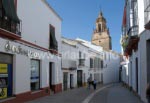Carmona, a small enchanting place

It is anyway worthwhile to have an extended stay in Carmona, this enchanting place between Sevilla and Córdoba. As a former popular whereabout of the Spanish monarchs, there are still today a lot of gorgeous palaces and churches in the city. The city wall of the Arabian times that surrounds the upper city of Carmona is a special highlight. Carmona is one of the most beautiful smaller cities of Andalusia.

The Plaza de San Fernando is the main plaza of Carmona, surrounded by gorgeous city houses and the city hall of the town. In the courtyard of the city hall of the Baroque times there is a mosaic on the ground from the Roman times that is much older.
The church Santa Maria cannot deny its Moorish history. The Orange Tree Courtyard with its horseshoe arches was from the time when there was still a mosque there. But there was a Christian church there before the time of the Moors of which the west gothic column of the 6th century is. On it, there is a calendar on which the name days of the Saints are carved. It is the oldest one that was found in Spain.

Another worthwhile seeing church is located in the lower town, the baroque church San Pedro. The interior of the church in the gorgeos extravagant baroque style is a feast to the eyes that one should not miss. The mix of Moorish elements and the tower that stands a little outside is surely not a coincidence. The builder of this church, Ambrosio Figueroa, was from Sevilla and he incorporated the Moorish arquitecture into his works.
Everywhere in the city there are signpostings indicating the way to the Parador de Carmona, the former castle Alcázar de arriba of which today is not much left. On this place there is now the stately Hotel Parador de Carmona.

In the travel guides, the special view from the Parador is always recommended; With the best will in the world, we cannot confirm this, as we were rather quite disappointed. Once being in the Parador, the view to the city is covered by the houses. There is certainly another terrace at the other side from which there is a view to the surrounding countryside, but despite the dry plain there is nothing else to see. We really could not understand what is so enchanting in this view. One possibly has an excellent view from one of the rooms in the upper floors, but the day visitor cannot proove this. Having enough time, one should preferrably explore the city centre with its city wall.
There, also the the city gates are interesting. In the west of the upper city there is the Puerta de Sevilla, a gate building with a horseshoe arch and three round archs. There is a tourist information centre accommodated in it; At the other end at the east there is the Puerta de Córdoba.
A little outside of Carmona, there is the Roman cemetery, another sightseeing. From a total of approximately 1000 graves from the second century BC up to the fourth century AD, approximately 250 are exposed and can be viewed. A museum informs about the funeral system of the Romans and shows some different burial objects.

Back to the index Andalusia
Author: Michael Nitzschke; Copyright: Patrick Wagner, www.tourist-guide.biz
|